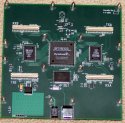Tiny board simplifies software-defined radio projects
Jun 7, 2006 — by LinuxDevices Staff — from the LinuxDevices Archive — 2 views A small consulting company is shipping an inexpensive add-on board targeting software-defined radio (SDR) projects. Ettus Research's $550 Universal Software Radio Peripheral (USRP) supports Linux and GNU Radio software, and is available with RF modules and antennas covering virtually the entire radio spectrum.
A small consulting company is shipping an inexpensive add-on board targeting software-defined radio (SDR) projects. Ettus Research's $550 Universal Software Radio Peripheral (USRP) supports Linux and GNU Radio software, and is available with RF modules and antennas covering virtually the entire radio spectrum.
(Click for larger view of the Ettus peripheral)
According to an article in Wired, the USRP board grew out of work funded by an education grant from the National Science Foundation, and motivated by an interest in using software radios to “usurp” broadcasters' control over hardware capable of receiving high-definition television signals. The board's creator, Jim Ettus, envisions a world in which increasing processing power enables all kinds of interesting peer-to-peer applications for high-bandwidth RF communications.
The USRP board attaches to “any computer” via a USB 2 port, and converts between analog and digital signals using an FPGA, according to Ettus's website. The board accepts up to four RF modules; Ettus currently stocks eight receiver, transmitter, and transceiver modules covering various RF spectra (currently “from DC through 2.9 GHz”), along with several tuned antennas built on PCBs (printed circuit boards).
The RF modules available for the USRP board are designed for experimentation, and thus require no radio licensing to operate, according to an FAQ on Ettus's website. They are also technically capable of use in actual radio devices, with the addition of additional circuitry, such as low-pass filters, amplifiers, and so on.
Since the USRP board was designed with the educational market in mind, it costs much less than typical peripherals needed by software-defined radio systems, the Wired article suggests. It depends on the host computer and GNU radio software to perform functions such as modulation/demodulation.
The USRP board and GNU Radio work with Linux, FreeBSD and NetBSD, Windows, and Max OS X (PPC and Intel), Ettus's website says. However, “primary development is done on Linux.”
Potential commercial SDR applications mentioned by the Wired article include the creation of real-time maps of cell-phone carriers in shopping malls, based on the carrier signals emitted by phones in motion. Such maps help mall designers, window dressers, and signage placers guage the effectiveness of their work, by showing where visitors tend to pause, and the places they congregate or avoid.
More details are available at the Ettus website, the GNU Radio webpage, and in the Wired article.
This article was originally published on LinuxDevices.com and has been donated to the open source community by QuinStreet Inc. Please visit LinuxToday.com for up-to-date news and articles about Linux and open source.